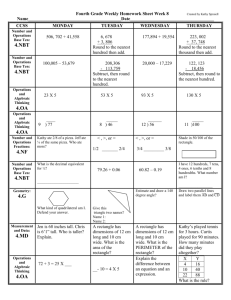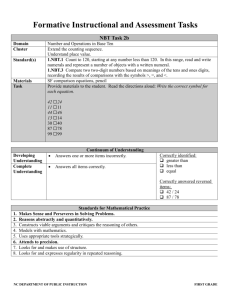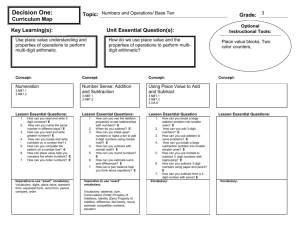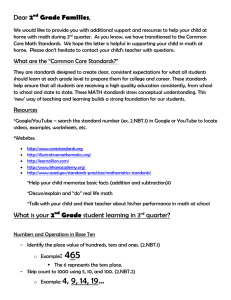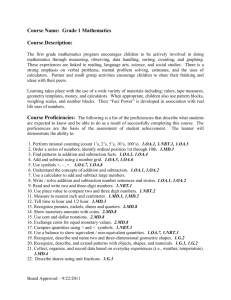File
advertisement
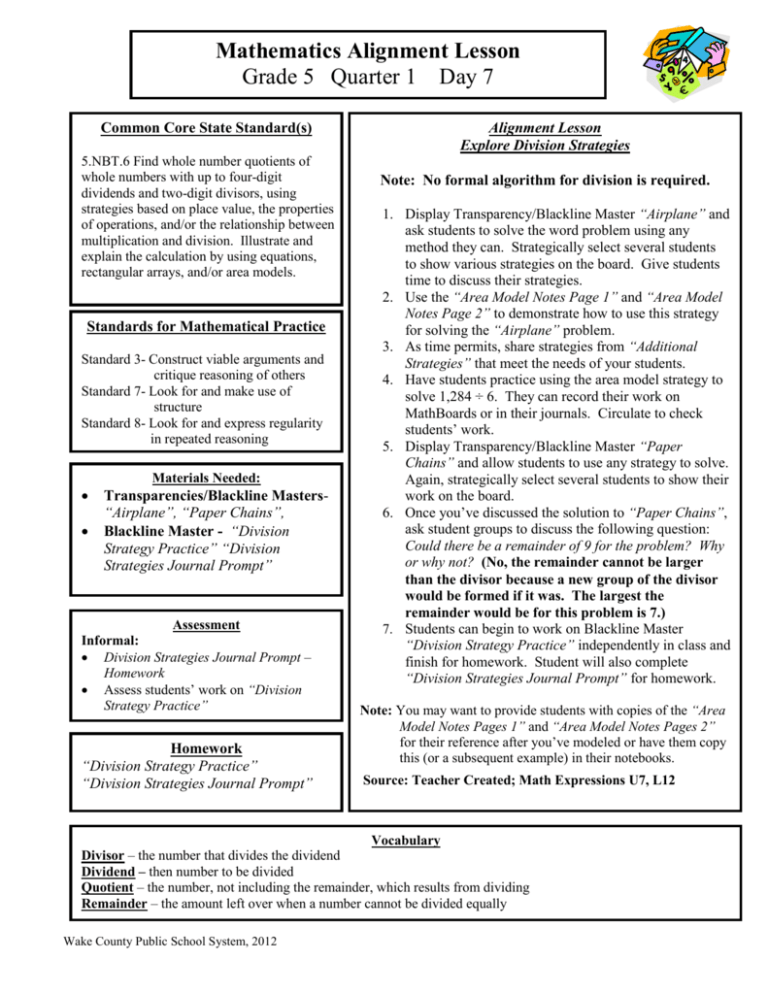
Mathematics Alignment Lesson Grade 5 Quarter 1 Day 7 Common Core State Standard(s) 5.NBT.6 Find whole number quotients of whole numbers with up to four-digit dividends and two-digit divisors, using strategies based on place value, the properties of operations, and/or the relationship between multiplication and division. Illustrate and explain the calculation by using equations, rectangular arrays, and/or area models. Standards for Mathematical Practice Standard 3- Construct viable arguments and critique reasoning of others Standard 7- Look for and make use of structure Standard 8- Look for and express regularity in repeated reasoning Materials Needed: Transparencies/Blackline Masters“Airplane”, “Paper Chains”, Blackline Master - “Division Strategy Practice” “Division Strategies Journal Prompt” Assessment Informal: Division Strategies Journal Prompt – Homework Assess students’ work on “Division Strategy Practice” Homework “Division Strategy Practice” “Division Strategies Journal Prompt” Alignment Lesson Explore Division Strategies Note: No formal algorithm for division is required. 1. Display Transparency/Blackline Master “Airplane” and ask students to solve the word problem using any method they can. Strategically select several students to show various strategies on the board. Give students time to discuss their strategies. 2. Use the “Area Model Notes Page 1” and “Area Model Notes Page 2” to demonstrate how to use this strategy for solving the “Airplane” problem. 3. As time permits, share strategies from “Additional Strategies” that meet the needs of your students. 4. Have students practice using the area model strategy to solve 1,284 ÷ 6. They can record their work on MathBoards or in their journals. Circulate to check students’ work. 5. Display Transparency/Blackline Master “Paper Chains” and allow students to use any strategy to solve. Again, strategically select several students to show their work on the board. 6. Once you’ve discussed the solution to “Paper Chains”, ask student groups to discuss the following question: Could there be a remainder of 9 for the problem? Why or why not? (No, the remainder cannot be larger than the divisor because a new group of the divisor would be formed if it was. The largest the remainder would be for this problem is 7.) 7. Students can begin to work on Blackline Master “Division Strategy Practice” independently in class and finish for homework. Student will also complete “Division Strategies Journal Prompt” for homework. Note: You may want to provide students with copies of the “Area Model Notes Pages 1” and “Area Model Notes Pages 2” for their reference after you’ve modeled or have them copy this (or a subsequent example) in their notebooks. Source: Teacher Created; Math Expressions U7, L12 Vocabulary Divisor – the number that divides the dividend Dividend – then number to be divided Quotient – the number, not including the remainder, which results from dividing Remainder – the amount left over when a number cannot be divided equally Wake County Public School System, 2012 Transparency/Blackline Master Grade 5 Day 7 Standards(s) 5. NBT.6 Airplane An airplane travels the same distance every day. It travels 3,822 miles in a week. How far does the airplane travel each day? Wake County Public School System, 2012 Teacher Guide Grade 5 Day 7 Standards(s) 5. NBT.6 Area Model Notes Page 1 Background: This method (referred to as Rectangle Sections in Math Expressions) is very concrete and shows that your goal is to find the unknown factor when we divide. With this method, you know the area of the rectangle and the length of one side, but we do not know the other side length. (from Math Expressions Teacher Guide p. 721) Step 1 – Create a rectangle (can either be longer horizontally or vertically) and label the known information. 7 3,822 Step 2 – Ask yourself “7 x what number is close to 3,822?” Think aloud that using numbers with zeros will make it easy to multiply. (500) Write 500 above this first section of the rectangle. Then, multiply 7 x 500 and subtract 3,500 from 3,822. 500 7 3,822 3,500 322 Step 3 – Build a new section of rectangle and write the remaining area (322) in the section. 500 7 3,822 3,500 322 Adapted from Math Expressions Wake County Public School System, 2012 322 Teacher Guide Grade 5 Day 7 Standards(s) 5. NBT.6 Area Model Notes Page 2 Step 4 – Ask yourself “7 x what number is close to 322?” Think aloud again that using numbers with zeros will make it easy to multiply. (40) Write 40 above this new section of the rectangle. Then, multiply 7 x 40 and subtract 280 from 322. 7 500 40 3,822 3,500 322 322 280 42 Step 5 – Build a new section of the rectangle and write the remaining area (42) in this section. 7 500 40 3,822 3,500 322 322 280 42 42 Step 6 – Ask yourself “7 x what number is close to or equal to 42?” (6) Write 6 above this new section of the rectangle. Then, multiply 7 x 6 and subtract 42 from 42. 7 500 40 6 3,822 3,500 322 322 280 42 42 42 0 Step 7 – Add the three new factors together (500 + 40 + 6 = 546). Since there was no remainder, 546 is the quotient. This gives you the length of the unknown side in the area model, which is the quotient. Adapted from Math Expressions Wake County Public School System, 2012 Teacher Guide Grade 5 Day 7 Standards(s) 5. NBT.6 Additional Strategies Student A – 3,822 ÷ 7 = I know I want to get to 3,822. There are 500 7’s in 3,822. 3,822 – 3,500 = 322 I know there are 40 7’s in 322 (there are not 50 7’s in 322 because that would be 350) 322 – 280 = 42 I know that there are 6 7’s in 42 42 – 42 = 0 500 + 40 + 6 = 546 (I just added up the groups of 7’s that I found in 3,822) Student B – Expanded Notation (using numbers with zero to make multiplying easier) 3,822 ÷ 7 = (3,000 + 800 + 20 + 2) ÷ 7 3,000 ÷ 7 – the closest I can get to 3,000 is 7 x 400 = 2,800 3,000 – 2,800 = 200 Add that 200 with the 800 from the expanded notation and I have 1,000 1,000 ÷ 7 – the closest I can get to 1,000 is 7 x 100 = 700 1,000 – 700 = 300 Add that 300 with the 20 from the expanded notation and I have 320 320 ÷ 7 – the closest I can get to 320 is 7 x 40 = 280 320 – 280 = 40 Add that 40 with the 2 from the expanded notation and I have 42 42 ÷ 7 – I know 42 divided by 7 is 6 Now, I add up the partial quotients 400 + 100 + 40 + 6 = 546 Student C 3,822 ÷ 7 = 3,822 3,500 500 322 280 42 42 40 + 0 6 546 Adapted from NC DPI Unpacking Document Wake County Public School System, 2012 There are 500 7’s in 3,822. I subtract 3,500 from 3,822 and have 322 left. There are 40 groups of 7 in 322. I subtract 280 from 322 and have 42 left. There are 6 groups of 7 in 42 (that’s a basic fact I know). I subtract 42 from 42 and have no remainder. To determine the quotient, I add up the partial quotients I used along the way and have the answer, 546. Transparency/Blackline Master Grade 5 Day 7 Standards(s) 5. NBT.6 Paper Chains The 1st grade teachers at Teal Ridge Elementary are creating paper chains to countdown the days of school. One teacher volunteered to cut the paper they’d need for the chains and cut 1,446 strips of paper. The paper will be evenly divided between the 8 teachers on the 1st grade team. How many strips of paper will each teacher receive? Teacher Created Wake County Public School System, 2012 Answer Key Grade 5 Day 7 Standards(s) 5. NBT.6 Paper Chains – Answer Key The 1st grade teachers at Teal Ridge Elementary are creating paper chains to countdown the days of school. One teacher volunteered to cut the paper they’d need for the chains and cut 1,446 strips of paper. The paper will be evenly divided between the 8 teachers on the 1st grade team. How many strips of paper will each teacher receive? 8 100 80 1,446 800 646 646 640 6 I began by creating a rectangle and labeling the information I knew (8 and 1,446). I then asked myself, “8 x what number is close to 1,446?” I know numbers with zeros are easier to work with so I used 100. I then multiplied 8 x 100 and subtracted 800 from 1,446. I still had 646 to divide so I created a new section on the rectangle and asked myself “8 x what number is close to 646?” I know numbers with zeros are easier to work with so I used 80 since I know that 8 x 8 = 64 and 8 x 80 would be 640. I then multiplied 8 x 80 and subtracted 640 from 646. I now have 6 left. I know that this is my remainder since it is smaller than the divisor. This means that each 1st grade teacher will get 180 strips of paper for their chains. (There will be 6 strips of paper leftover.) Teacher Created Wake County Public School System, 2012 Blackline Master Grade 5 Day 7 Standard(s) 5. NBT.6 Division Strategy Practice Use the area model to solve the following: 1. 2,106 ÷ 9 2. 5,380 ÷ 6 Use any strategy to solve the following: 3. 4,914 ÷ 5 4. 3,372 ÷ 4 5. Nicky has $1,536 in his bank account and plans to spend the same amount each month for the next 6 months. How much money will he spend each month? Wake County Public School System, 2012 Answer Key Grade 5 Day 7 Standards(s) 5. NBT.6 Division Strategy Practice – Answer Key Use the area model to solve the following: 1. 2,106 ÷ 9 9 2. 5,380 ÷ 6 6 Answer: 234 200 30 4 2,106 1,800 306 306 270 36 36 36 0 800 90 6 5,380 4,800 580 580 540 40 40 36 4 Answer: 896 r 4 Use any strategy to solve the following: 3. 4,914 ÷ 5 Strategies will vary. 4. Answer: 982 r 4 3,372 ÷ 4 Strategies will vary. Answer: 843 5. Nicky has $1,536 in his bank account and plans to spend the same amount each month for the next 6 months. How much money will he spend each month? Strategies will vary. Wake County Public School System, 2012 Answer: $256 Blackline Master Grade 5 Day 7 Standards(s) 5. NBT.6 Name: ________________________ Date: ________________________ Division Strategies Journal Prompt Choose one of the problems from Division Strategy Practice and write a letter to a friend to explain the method you used to solve it. Wake County Public School System, 2012
